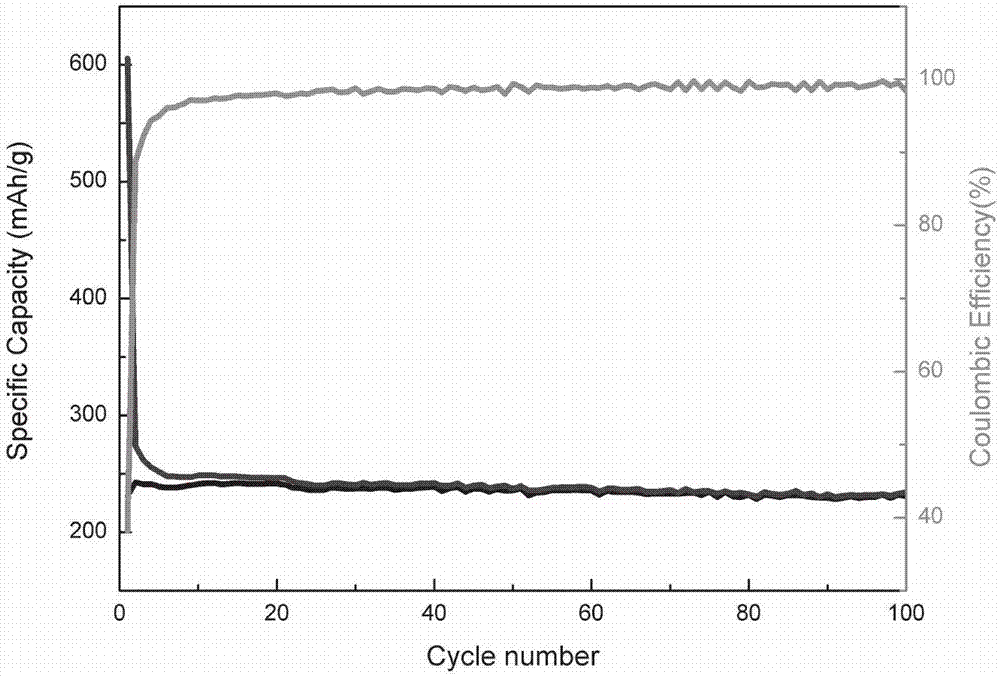Three-dimensional porous carbon material and preparation thereof, and application of three-dimensional porous carbon material in sodium ion battery
A three-dimensional porous, carbon material technology, applied in nanotechnology for materials and surface science, carbon preparation/purification, battery electrodes, etc. Super strong structural stability, high cross-linking degree and excellent sodium storage performance
- Summary
- Abstract
- Description
- Claims
- Application Information
AI Technical Summary
Problems solved by technology
Method used
Image
Examples
Embodiment 1
[0053] Put 10 g of smectite ore in a solution (aqueous solution of alkali) with a pH of 8.5 for ultrasonic dispersion, put 1 g of dopamine in the above solution, control the polymerization temperature to 30 ° C, and control the polymerization time to 40 h, and the obtained precursor is carbonized. Inert gas protection is introduced, carbonization (heat treatment) is performed at a temperature of 400° C. for 1 hour, and the resulting product is washed with hot sodium hydroxide to obtain a carbon nanosheet material. The obtained carbon nanosheet material was added to a solution with a CTAB (cetyltrimethylammonium bromide) concentration of 1 g / L, ultrasonically dispersed, placed in a hydrothermal reaction kettle, and the hydrothermal reaction temperature was controlled to be 200 ° C. The thermal reaction time is 12h. The obtained hydrothermal product is heat-treated, protected by inert gas, and the carbonization temperature is 1000° C. for 2 hours to obtain a three-dimensional po...
Embodiment 2
[0056] Compared with Example 1, the only difference is that the carbonization (heat treatment) temperature after the hydrothermal reaction is 500°C. The thickness of the obtained carbon nanosheets is concentrated at about 60nm, and the specific surface area of the obtained airgel material is 1540m 2 / g.
[0057] The three-dimensional porous carbon material prepared in this example was used as the working electrode, sodium was used as the counter electrode, and a button battery was assembled, and the capacity performance was tested at a current density of 50 mA / g. The test results show that the sodium ion battery negative electrode prepared in this example has good electrochemical properties: at a flow density of 50mA / g, after 100 cycles, the specific capacity of 202mA / g can still be maintained (the capacity retention rate is 98%).
Embodiment 3
[0059] Put 20g of smectite ore in a solution with a pH of 8.5 for ultrasonic dispersion, put 1g of dopamine in the above solution, control the polymerization temperature at 50°C, and control the polymerization time at 20h. The obtained precursor is carbonized and protected by inert gas. , the carbonization treatment temperature is 500° C., and the time is 2 hours. The obtained product is washed with hot sodium hydroxide to obtain a carbon nanosheet material. The obtained carbon nanosheet material was added to a solution with a CTAB concentration of 0.5 g / L, ultrasonically dispersed, placed in a hydrothermal reaction kettle, and the hydrothermal reaction temperature was controlled at 160° C., and the hydrothermal reaction time was 24 hours. The obtained hydrothermal product was heat-treated, protected by inert gas, and the carbonization temperature was 1100° C. for 4 hours to obtain a three-dimensional porous carbon material. The thickness of carbon nanosheets is concentrated a...
PUM
| Property | Measurement | Unit |
|---|---|---|
| thickness | aaaaa | aaaaa |
| concentration | aaaaa | aaaaa |
| thickness | aaaaa | aaaaa |
Abstract
Description
Claims
Application Information
 Login to View More
Login to View More - R&D
- Intellectual Property
- Life Sciences
- Materials
- Tech Scout
- Unparalleled Data Quality
- Higher Quality Content
- 60% Fewer Hallucinations
Browse by: Latest US Patents, China's latest patents, Technical Efficacy Thesaurus, Application Domain, Technology Topic, Popular Technical Reports.
© 2025 PatSnap. All rights reserved.Legal|Privacy policy|Modern Slavery Act Transparency Statement|Sitemap|About US| Contact US: help@patsnap.com


